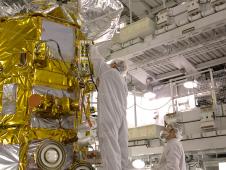 Preparations continue for the June 9, 7:20 a.m. launch of the international Aquarius/SAC-D observatory satellite from NASA’s Space Launch Complex at Vandenberg Air Force Base, Ca. The satellite will study connections between ocean circulation, the water cycle and climate by measuring ocean surface salinity. Global ocean salinity has been an area of much scientific uncertainty. Past measurements of salinity have been limited mostly to summertime observations in shipping lanes. Aquarius will map the entire ocean every day for at least three years from an altitude of 657 km (408 miles). The measurements will help scientists understand how salinity changes over time. Because ocean surface salinity varies from place to place and over time, scientists can use it to trace the ocean’s role in Earth’s water cycle. Aquarius will reveal how salinity variations influence ocean circulation and the water cycle, which help determine the Earth’s climate.
Preparations continue for the June 9, 7:20 a.m. launch of the international Aquarius/SAC-D observatory satellite from NASA’s Space Launch Complex at Vandenberg Air Force Base, Ca. The satellite will study connections between ocean circulation, the water cycle and climate by measuring ocean surface salinity. Global ocean salinity has been an area of much scientific uncertainty. Past measurements of salinity have been limited mostly to summertime observations in shipping lanes. Aquarius will map the entire ocean every day for at least three years from an altitude of 657 km (408 miles). The measurements will help scientists understand how salinity changes over time. Because ocean surface salinity varies from place to place and over time, scientists can use it to trace the ocean’s role in Earth’s water cycle. Aquarius will reveal how salinity variations influence ocean circulation and the water cycle, which help determine the Earth’s climate.
For information and activities about Earth observing satellites and Earth’s weather and climate, check out the NASA Explorer Schools module, Earth Climate Course.
For more information about Aquarius visit the mission website.
